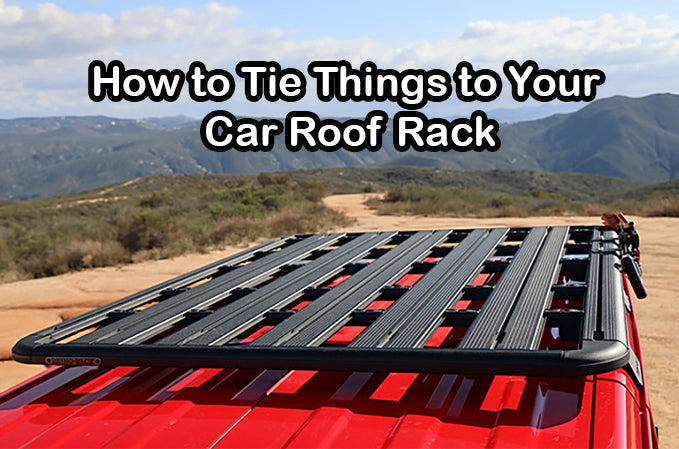Having extra cargo that just won't fit in your trunk does not always warrant a call to U-Haul, especially if you are moving only a few items that are not too heavy. If you know how to secure items properly on your roof rack, you might save yourself a good buck. However, if you don't know how to tie things to your roof rack properly, read on for some tips that may prove very helpful.
Check the Placement and Safety Requirements
Most cars will come with the manufacturer’s instructions and recommendations regarding the transportation of items on the roof rack. Check to make sure that your cargo does not exceed the weight limitations. Generally, larger cars and trucks made for off-road drives (such as SUVs and Jeeps) can carry a lot more weight than a smaller model such as a sedan.
If the item is a long object, its placement may affect road visibility and the weight balance. Be sure to place it centrally in a way that it won't slide off on either side and obstruct your view of the road, or shift too much weight on one side.

Use Secure Tie-Downs and Reinforce Where Possible
You should also make sure that you use solid ropes or tie-downs. If they snap at any point during transportation, the item could easily fly off into oncoming traffic and cause accidents.
Some of the most common tie-downs include ratchet and bungee cord straps:
- Bungee cord tie-downs – Even though these are strong, they flex very quickly and are likely to loosen, causing the items to move during transit. The cargo could slide off and into the traffic or get damaged due to the movement.
- Ratchet tie-downs – These are also strong but can easily start cutting through your cargo, especially when they are too tight. They are game if your items are relatively solid or hard to damage.
- Ropes – Ropes are a relatively secure option if you know how to work some serious knots. They are hard to break but not a great choice if you are tying the items through the car – the thickness would not allow the door to close over them.
- Web strapping – Disregarding the fact that they are considerably more expensive than the other options, web strapping is ideally the best alternative for secure and accident-free roof rack transportation. They are firm and often come with buckles which make it very easy to secure and release cargo.
Tie the Cargo Down Firmly at Multiple Places
Anchor down your cargo as firmly as possible without damaging it. If, for instance, you are transporting something that could easily slide off the ties like pipes, be sure to tie them down in at least three places: the front, back, and middle.
You should also consider your aerodynamics. Make sure to place your item in a way that reduces wind resistance as much as possible. A good practice is to place the item where the roof starts or a bit further down. If the weight is not balanced evenly, place the heaviest part at the front and the lighter parts further back.
Most importantly, do not tie down any cargo that exceeds the width of your vehicle; it is not only dangerous but is also illegal in most US states.

Choose A Suitable Roof Rack and Make Sure That It Is Installed Correctly
If you don’t usually transport items on your car roof, you probably don't have a roof rack. You can still tie your things on the roof, but you will need to run the ropes through the car's interior. It is advisable to use thin ties so you can close the door over them easily. If your ropes run through an open window, it could damage the door during transport and make it difficult for passengers to get out.
If you decide to buy a rack, make sure that it suits your needs. It could be a simple pair of side racks installed on each side or a more complex one with crossbars and hood loops.
Inno IN-SUT roof rack system is a custom fit roof rack for all years, makes and models on the road today without rain gutters or factory racks. If your vehicle has a bare or smooth roofline then the Inno Racks IN-SU roof rack system is the roof rack solution for your vehicle. Telescopic adjustment knobs on the Inno IN-SU system makes for easy installation on your vehicle. Inno is a top quality product that comes with a limited lifetime factory warranty.
You may also consider the Rhino-Rack Pioneer Platform. It is a sleek and stylish load carrying solution. Made with strong, durable and lightweight reinforced nylon and aluminum, these non-corrosive Pioneer Platforms have been tested in the most rugged conditions and have passed with flying colors. Other roof top baskets are manufactured by Warrior. They are the perfect year-round roof top carrier for all your gear, with a substantial weight capacity. Featuring a permanent mount design for Jeeps, they still allow the removal of a soft or hardtop without removing the rack. The rack is built of steel and powder-coated black for lasting durability. For Cherokees, the basket can mount by specially designed footings to the rain gutters.
Whatever your choice, make sure that it is installed correctly.

Check the Cargo After Securing It
After securing your items, make sure that you check them thoroughly before starting the car. Go around the vehicle and make sure that the cargo is secured, that the tie-downs are strong enough to hold it through the drive and that the weight is not slumping on one side. You should also check that it is not tied too tightly to get damaged, especially if you will be driving on off-road terrain with bumps and potholes. When you are done, start the vehicle and move a couple of feet to ensure that everything is intact. If it is a long drive, stop to check now and then, especially after covering a considerably bumpy patch.
Other Safety Considerations
- You should tie overhanging items at the sides, front and back, and secure them as tight as you possibly can without risking damage.
- Do not tie cargo to any plastic parts of your car, including the bumper. Instead, find a solid metallic piece such as the rear hitch or tow hooks under the front bumper.
- If the tie-downs are secured to any part at the front of the car, make sure that they do not obscure your road visibility.
- Secure separate items as close to each other as possible to minimize the risk of them shifting and smashing into each other during transport.
- Driving very fast will increase wind drag and blow up your gas expenditure, especially if the cargo is not streamlined. It can also create a stronger updraft that can pull the items up, increasing the risk of damaging the vehicle, cargo and causing an accident.
In conclusion, all you need to secure your items on a roof rack is a couple of strong tie-downs, a good placement, and maybe some help. Do not forget to listen for rattling or odd noises during transit – they usually mean that the cargo is loose and moving around.
Looking for auto accessories for your car, SUV, UTV, Truck or Jeep? Visit AutoPartsToys.com - a leading online superstore where you can find top brand accessories at factory direct prices and free shipping on orders over $50




Comments (0)